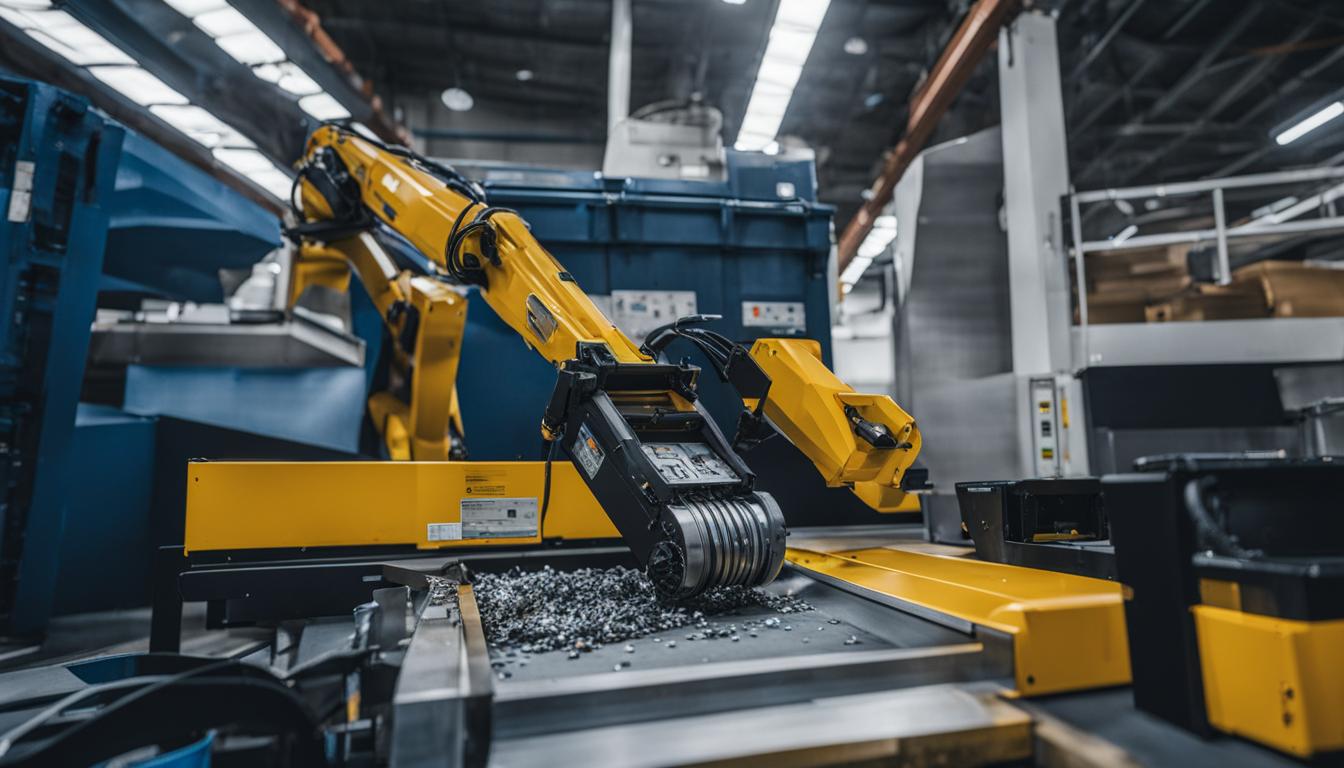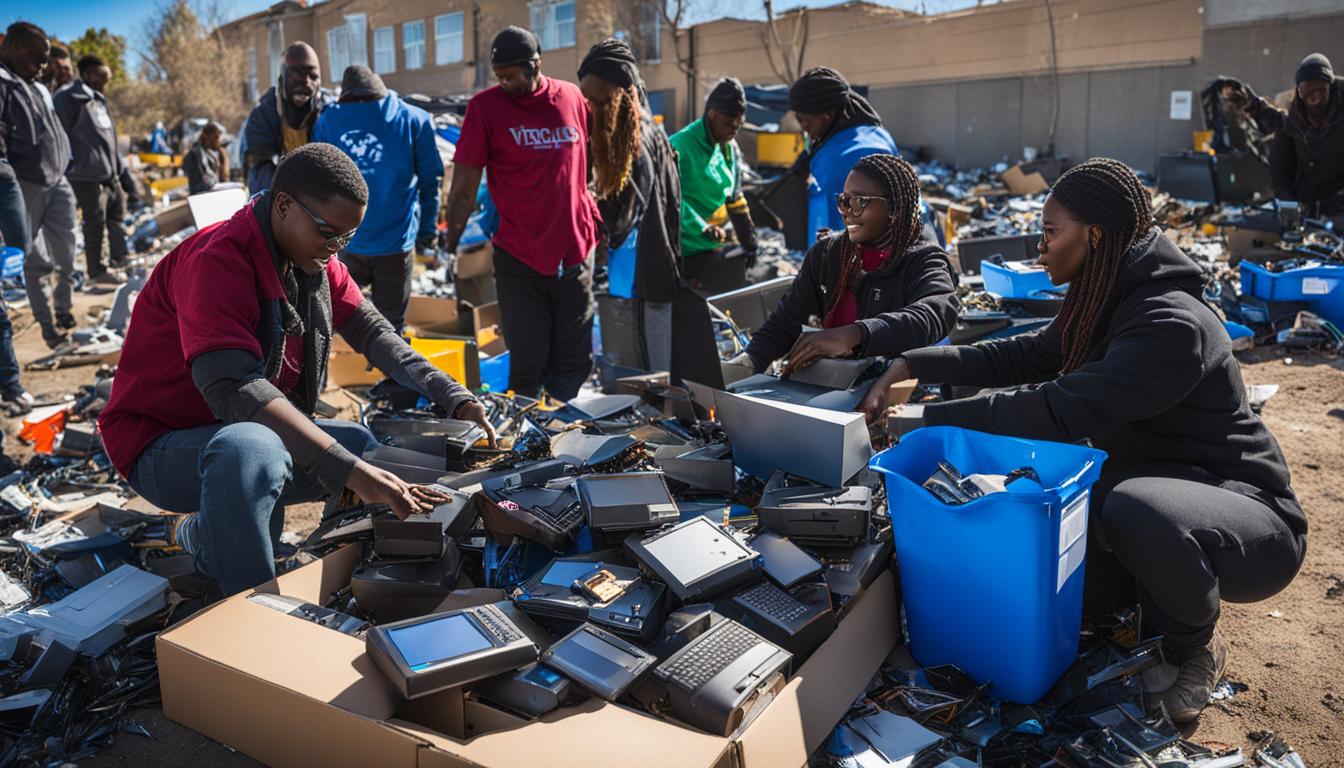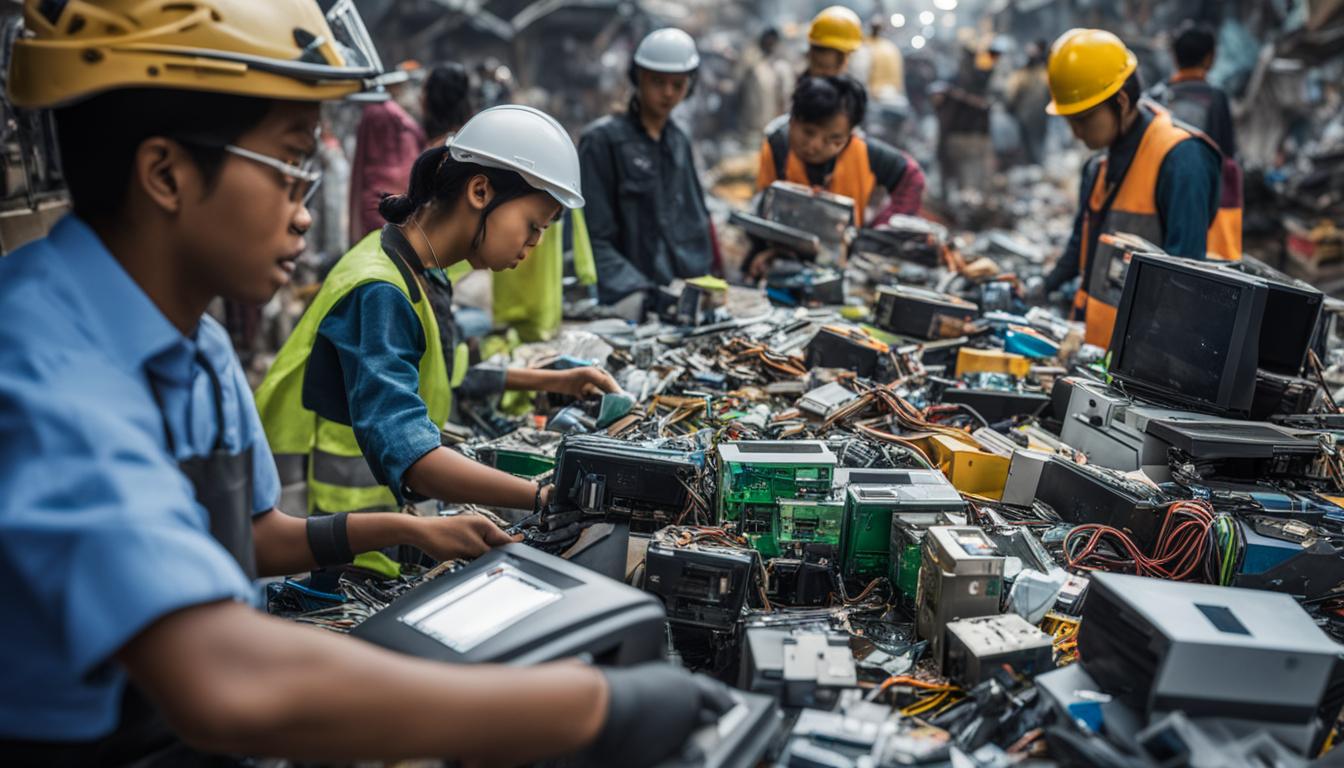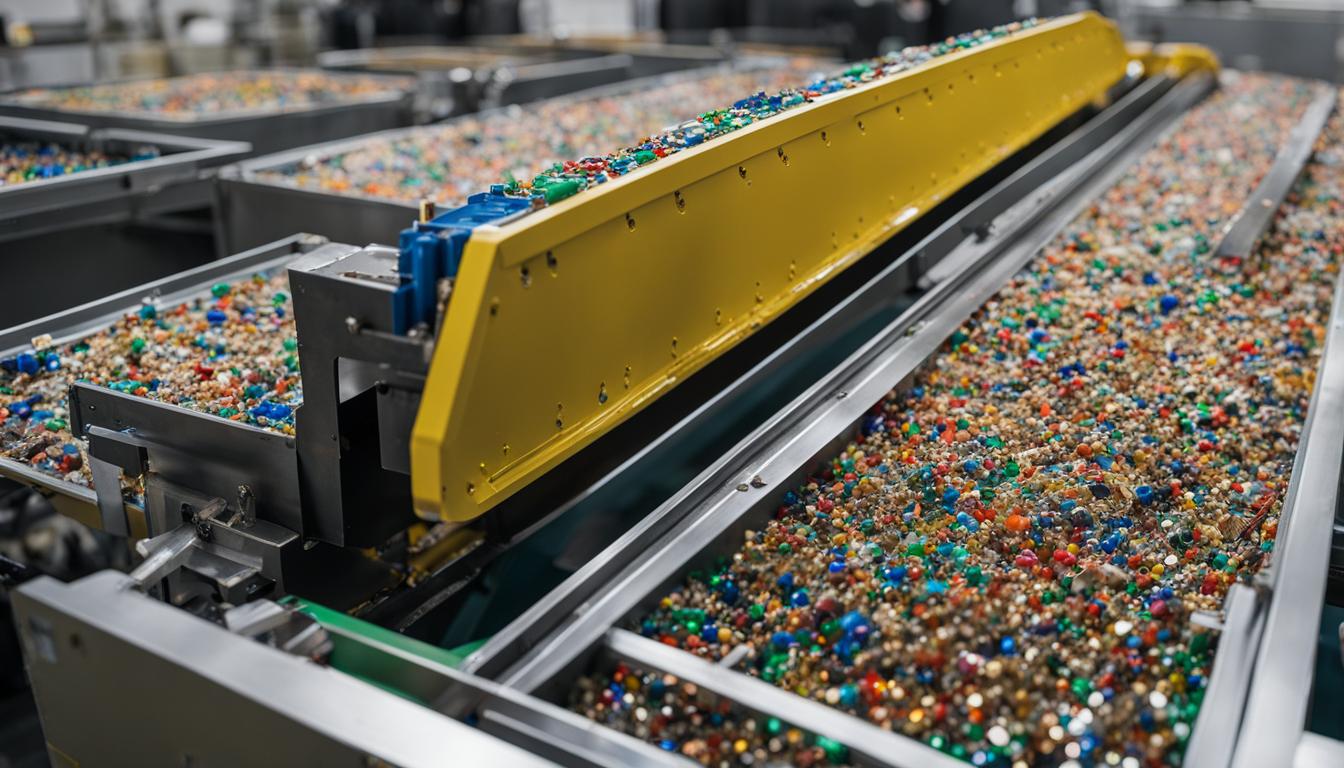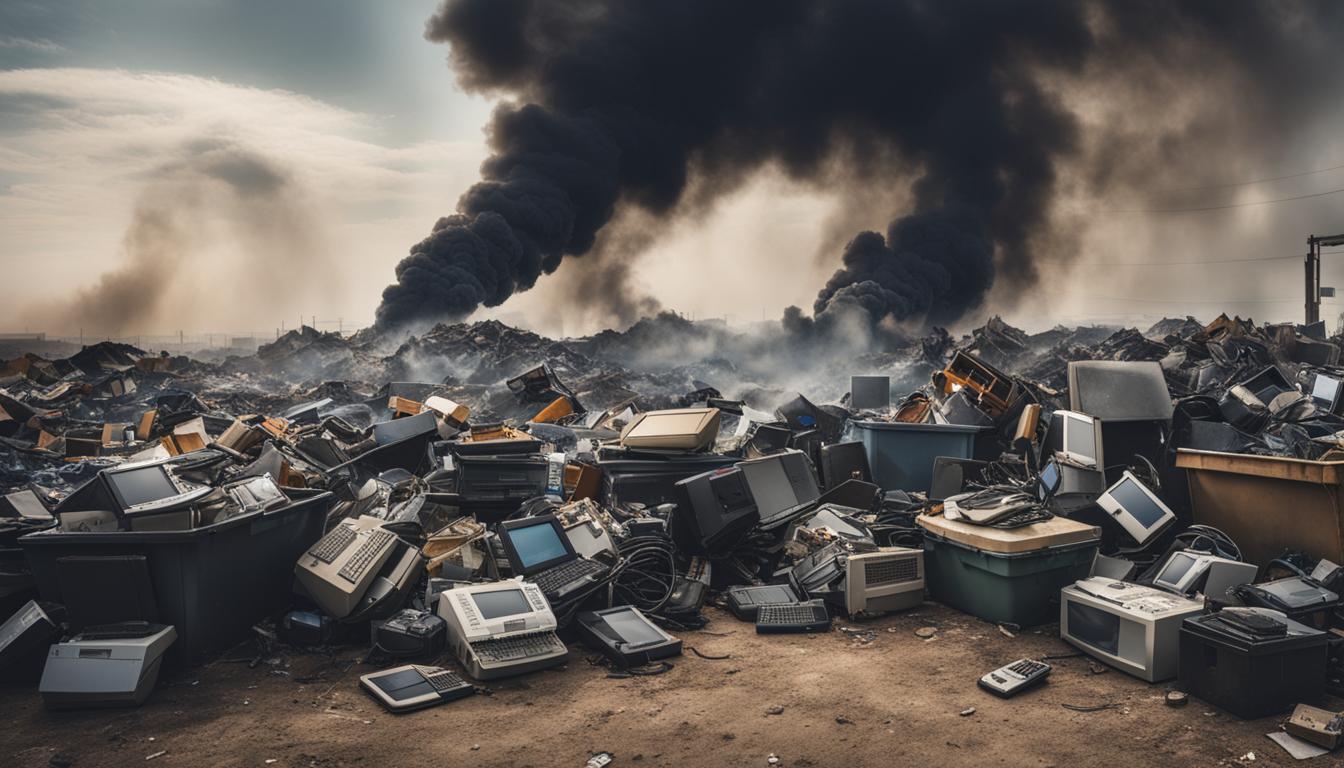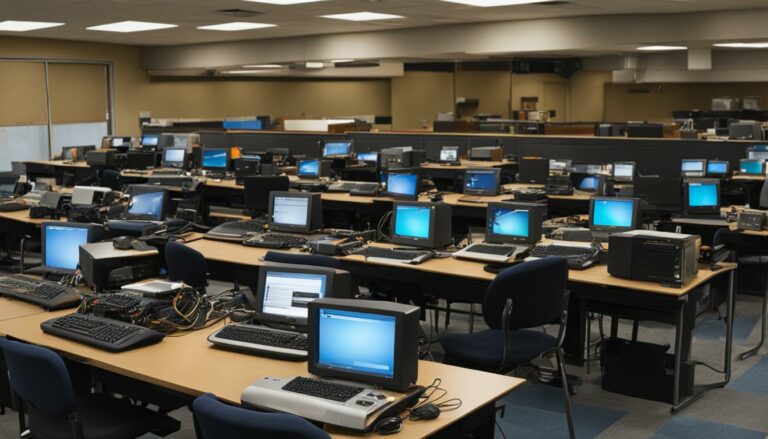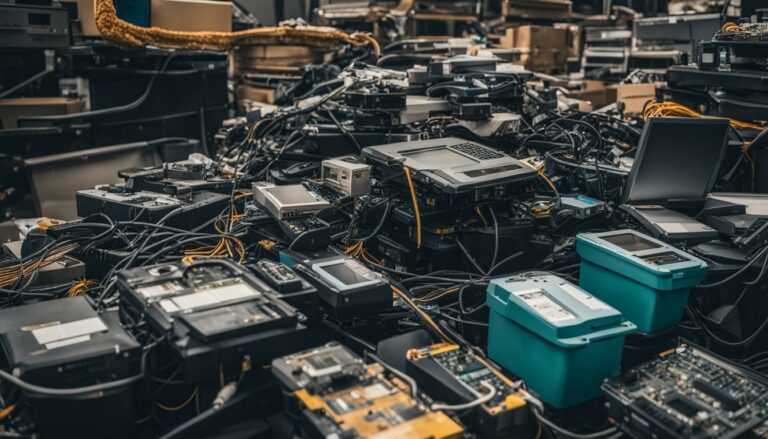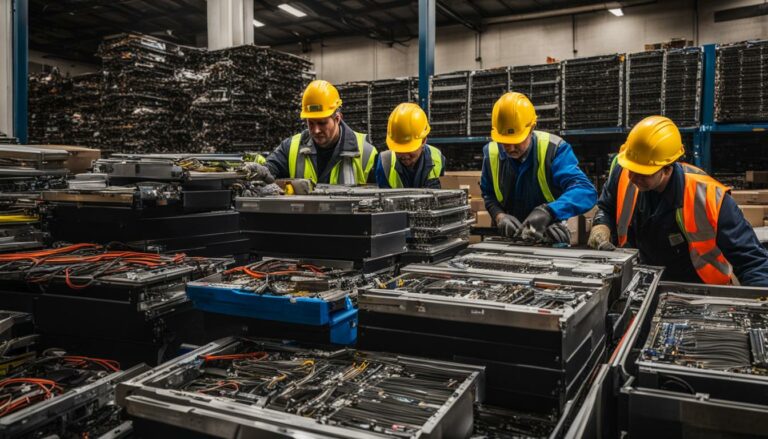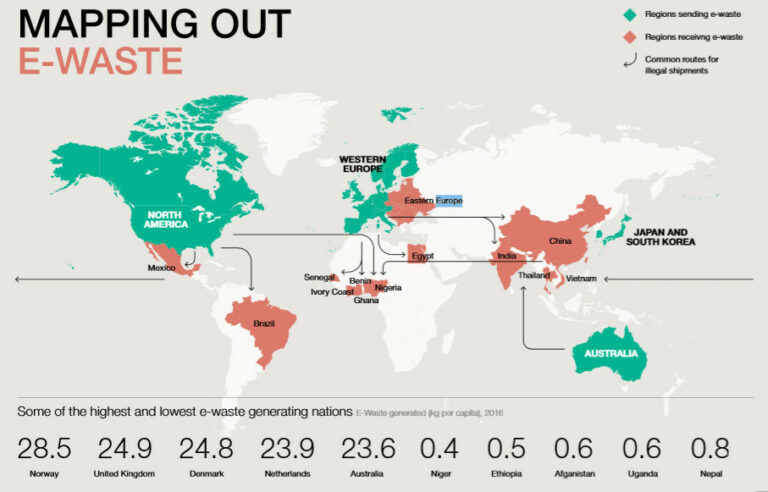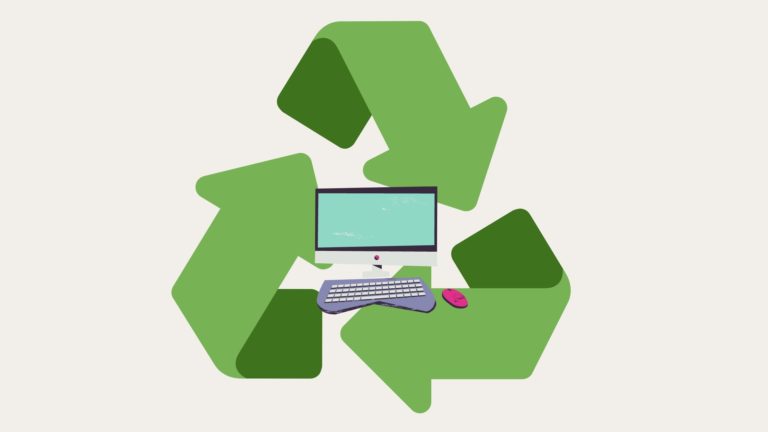Responsible Disposal: Navigating IT Recycling Options
As our reliance on electronic devices continues to grow, so does the challenge of managing their disposal and recycling responsibly. Improper disposal of e-waste can lead to environmental pollution and waste of valuable resources. The solution lies in consumer education, extended producer responsibility, establishing e-waste collection centres, and promoting safe recycling practices.
Key Takeaways
- Responsible e-waste management involves consumer education and promoting safe recycling practices.
- Improper disposal of electronic devices can lead to environmental pollution and resource wastage.
- Extended producer responsibility programs can help ensure responsible disposal of IT equipment.
- E-waste collection centres play a crucial role in facilitating the proper recycling of electronic devices.
- Prioritizing sustainable practices is essential for a future where electronic devices are recycled and disposed of responsibly.
The Problem of E-Waste
The proliferation of electronic devices has led to a surge in e-waste generation. As technology advances rapidly, old electronic devices quickly become obsolete, resulting in a significant increase in the amount of electronic waste being produced. This poses a major problem as improper disposal of e-waste can have serious implications for the environment and human health.
E-waste often contains hazardous materials such as lead, mercury, cadmium, and brominated flame retardants. When electronic devices are not disposed of properly, these hazardous substances can leach into the soil and groundwater, polluting our ecosystems and potentially endangering the health of both humans and wildlife. Furthermore, the improper handling and recycling of e-waste can release toxic gases into the air, contributing to air pollution and further exacerbating the environmental impact.
Awareness of the environmental consequences of e-waste is crucial in addressing this growing problem. It is important for individuals and businesses to recognize the need for responsible electronic waste disposal and take the necessary steps to prevent the harmful effects of improper disposal.
“The irresponsible disposal of electronic waste has severe consequences for both the environment and human health. Hazardous materials present in e-waste can contaminate our air, water, and soil, threatening the delicate balance of ecosystems and putting human lives at risk.”
The Impact of E-Waste Generation
The rapid rate of e-waste generation has far-reaching consequences not only for the environment but also for resource conservation. Electronic devices often contain valuable and scarce materials such as gold, silver, and copper. When these devices are not recycled properly, these resources go to waste. Mining for these minerals not only depletes our natural resources but also contributes to deforestation, habitat destruction, and increased greenhouse gas emissions.
Additionally, the energy-intensive manufacturing processes involved in producing electronic devices contribute to carbon emissions and climate change. By properly recycling and reusing electronic devices, we can reduce the demand for raw materials, decrease energy consumption, and mitigate the environmental impact associated with their production.
Addressing the problem of e-waste requires a collaborative effort from governments, manufacturers, and consumers. Implementing effective recycling programs, establishing collection centers, and promoting responsible e-waste disposal practices are essential in minimizing the negative impacts of electronic waste on our environment and creating a sustainable future.
| E-Waste Generation | Hazardous Materials | Environmental Impact | Resource Conservation |
|---|---|---|---|
| Increasing due to rapid technological advancements | Contains hazardous substances such as lead and mercury | Pollution of soil, water, and air | Valuable materials go to waste |
| Improper disposal poses risks to human health | Release of toxic gases during improper recycling | Affects ecosystems and wildlife | Depletion of natural resources |
| Requires awareness and responsible disposal | Contributes to air and water pollution | Climate change impact through energy-intensive manufacturing | Reduces the need for mining and deforestation |
The Ripple Effects
Improper disposal of e-waste not only contributes to environmental pollution but also leads to the waste of valuable resources. Many electronic devices contain precious metals that can be recovered through proper recycling processes. Responsible recycling practices can help conserve resources and reduce the need for environmentally damaging mining activities.
Electronic waste, if not disposed of responsibly, poses a significant threat to the environment. The substances and components found in electronic devices can leach harmful chemicals into the soil and water, leading to pollution and the degradation of ecosystems. Additionally, by not responsibly recycling e-waste, we are squandering the opportunity to recover valuable resources that can be used in the production of new devices.
Responsible recycling processes are essential to mitigate the negative impacts of e-waste. By recycling electronic devices, we can not only prevent hazardous substances from entering the environment but also recover valuable materials such as gold, silver, and copper. These recovered resources can then be reused in the manufacturing of new products, reducing the need for extraction and minimizing the environmental footprint associated with mining.
| Environmental Impact of Improper E-Waste Disposal | Benefits of Responsible Recycling Processes |
|---|---|
| 1. Environmental pollution | 1. Prevention of hazardous substances from entering the environment |
| 2. Waste of valuable resources | 2. Recovery of precious metals and other valuable materials |
| 3. Increased need for mining activities | 3. Reduction in the environmental footprint associated with mining |
The Environmental Impact of Improper E-Waste Disposal
“Improper disposal of e-waste can lead to the contamination of soil and water, causing harm to ecosystems and posing risks to human health.” – Environmental Agency Report
The Solution: Responsible Disposal and Recycling
In order to address the growing problem of e-waste, it is essential to adopt a comprehensive approach that encompasses consumer education, extended producer responsibility, the establishment of e-waste collection centers, and the promotion of safe recycling practices. By implementing these measures, we can ensure the responsible disposal and recycling of electronic devices, mitigating their environmental impact and conserving valuable resources.
Consumer education plays a crucial role in fostering awareness about the importance of responsible e-waste disposal. Many individuals may not be aware of the potential environmental and health hazards associated with improper disposal methods. By providing information about the proper channels for recycling and disposing of electronic devices, we can empower consumers to make informed choices and contribute to a more sustainable future.
Extended producer responsibility programs place the onus on manufacturers to take responsibility for the entire lifecycle of their products, including their disposal. By ensuring that manufacturers are responsible for the collection and recycling of their electronic devices, we can incentivize the development of more environmentally friendly products and sustainable production processes.
Establishing e-waste collection centers in accessible locations is essential for providing consumers with convenient options for disposing of their electronic devices. These centers should be equipped with the necessary infrastructure and resources to handle e-waste safely and efficiently. Additionally, they can serve as hubs for community outreach and education, promoting the benefits of responsible recycling practices and encouraging individuals to make use of the available facilities.
| Consumer Education | Extended Producer Responsibility | E-Waste Collection Centers | Safe Recycling Practices |
|---|---|---|---|
| Raises awareness about responsible e-waste disposal | Makes manufacturers accountable for their products | Provides convenient and accessible disposal options | Ensures proper handling and recycling of e-waste |
| Empowers consumers to make informed choices | Incentivizes sustainable production processes | Serves as a hub for community outreach and education | Reduces environmental and health risks |
| Encourages participation in recycling initiatives | Promotes the development of eco-friendly products | Minimizes the illegal dumping of e-waste | Conserves valuable resources |
Promoting safe recycling practices is crucial to ensure that electronic devices are recycled in an environmentally friendly manner. This includes the proper handling and dismantling of devices to recover valuable materials, as well as the safe disposal of hazardous components. By implementing stringent recycling standards and regulations, we can prevent the release of harmful substances into the environment and maximize the recovery of reusable resources.
By embracing consumer education, extended producer responsibility, establishing e-waste collection centers, and promoting safe recycling practices, we can pave the way for a more sustainable future. These initiatives not only help mitigate the environmental impact of e-waste but also contribute to the conservation of valuable resources. It is imperative that businesses, individuals, and governments work together to prioritize responsible disposal and recycling practices, ensuring that electronic devices continue to drive progress without causing harm to our planet.
Protecting the Environment with Responsible Disposal
Proper disposal of electronics is essential for safeguarding the environment and minimizing the negative impact of e-waste. The compounds and chemicals used in the manufacturing process of electronic devices can have detrimental effects on our ecosystems if not disposed of responsibly. By embracing responsible disposal methods such as recycling, donating, or returning devices, we can significantly reduce the environmental risks associated with e-waste.
“Responsible disposal of electronics is crucial for protecting our planet. It is our collective responsibility to ensure that these devices, which have become an integral part of our lives, do not end up polluting the environment. Recycling and safe disposal practices are key to creating a sustainable future.” – Environmental expert
One way to promote responsible electronics disposal is by adopting a circular economy approach. A circular economy aims to maximize the use of materials and minimize waste through strategies such as reusing components, recycling internal parts, and repurposing materials for new products. By embracing a circular economy mindset, we can create a more sustainable and resource-efficient future in the electronics industry.
The Benefits of a Circular Economy for Electronics
A circular economy for electronics offers several advantages. First, it helps conserve valuable resources by reducing the need for raw material extraction. By reusing and recycling materials, we can minimize the environmental impact associated with mining and manufacturing processes. Second, a circular economy approach promotes the development of innovative technologies and business models that prioritize durability, repairability, and upgradability, extending the lifespan of electronic devices and reducing overall waste.
Furthermore, a circular economy can contribute to job creation and economic growth. The repair, refurbishment, and recycling sectors require skilled labor, creating employment opportunities in sustainable industries. Embracing a circular economy for electronics not only protects the environment but also supports a prosperous and resilient economy.
| Benefits of Responsible Electronics Disposal | Circular Economy Approach |
|---|---|
| Minimizes environmental pollution | Reduces the need for raw material extraction |
| Conserves valuable resources | Extends the lifespan of electronic devices |
| Promotes sustainable technologies | Reduces overall waste |
| Creates employment opportunities | Supports a resilient economy |
Circular Consumer Electronics

In the pursuit of a sustainable future, adopting a circular economy approach to consumer electronics is vital. This approach focuses on extending the useful life of devices, reusing materials, and recycling internal components and materials for the creation of new products. By embracing circular consumer electronics practices, we can minimize the environmental impact of e-waste, maximize resource utilization, and promote sustainability.
One key aspect of the circular economy approach is extending the lifespan of devices through reuse. Instead of discarding electronics when they are no longer the latest model, consumers are encouraged to consider alternative uses or pass them on to others who may find them useful. This not only reduces the amount of electronic waste but also maximizes the value extracted from each device.
Additionally, utilizing devices for cloud computing can further contribute to the circular economy. Cloud computing allows users to access and utilize computing resources without the need for physical hardware. By harnessing the power of the cloud, the demand for new devices can be reduced, leading to fewer resources being extracted and less waste being generated.
Advantages of Circular Consumer Electronics:
- Prolonged device lifespan through reuse
- Reduced demand for new devices
- Maximized resource utilization and waste reduction
- Promotion of a sustainable and responsible future
By reusing materials and recycling internal components and materials, the circular economy approach to consumer electronics fosters a closed-loop system. This means that resources are continuously utilized and waste is minimized, aligning with the principles of sustainability and responsible resource management.
| Key Elements of a Circular Economy for Electronics | Benefits |
|---|---|
| Reuse of devices | Extended device lifespan, reduced e-waste |
| Cloud computing | Reduced demand for new hardware, resource conservation |
| Recycling of materials | Resource recovery, reduced need for virgin materials |
Conclusion
Responsible IT asset disposal is of paramount importance in addressing the pressing issue of e-waste. By raising awareness, implementing extended producer responsibility programs, establishing e-waste collection centers, and promoting safe recycling practices, we can ensure the ethical, efficient, and eco-friendly disposal of obsolete IT equipment. It is imperative for businesses and individuals to prioritize sustainable practices and contribute to a future where electronic devices are recycled and disposed of responsibly.
By embracing eco-friendly recycling methods, we can minimize the adverse environmental impact of e-waste. Ethical disposal practices, such as recycling, repurposing, or donating devices, play a crucial role in reducing electronic waste and preserving our planet. Adopting these practices not only safeguards the environment but also conserves valuable resources, paving the way for a more sustainable future.
IT asset disposal should be a conscientious process, considering the potential harm that electronic waste can cause when not handled properly. As technology advances, it is essential to keep pace with eco-friendly recycling practices. By choosing ethical disposal options, we can contribute to a circular economy and ensure that valuable materials are reused, reducing the need for raw material extraction and minimizing waste. Let us strive for a responsible and sustainable approach to IT asset disposal, and together, we can make a positive impact on the environment and create a better world for future generations.
FAQ
What is e-waste?
E-waste refers to electronic waste, which includes discarded electronic devices such as computers, mobile phones, televisions, and appliances.
Why is responsible disposal of e-waste important?
Responsible disposal of e-waste is important to prevent environmental pollution, protect human health, and conserve valuable resources.
How can I dispose of my electronic devices responsibly?
You can dispose of electronic devices responsibly by recycling them at designated e-waste collection centers, donating them for reuse, or returning them to manufacturers for proper disposal.
What is extended producer responsibility?
Extended producer responsibility is a policy approach that holds manufacturers accountable for the entire life cycle of their products, including the proper disposal and recycling of electronic devices.
Can I recycle internal components and materials of electronic devices?
Yes, recycling internal components and materials of electronic devices is an important part of a circular economy approach to electronics, which helps minimize waste and maximize resource utilization.
How can I protect the environment when disposing of electronics?
You can protect the environment by choosing responsible disposal methods such as recycling, donating, or returning electronic devices. These methods help reduce the negative impact of e-waste on the environment.
What are the benefits of a circular economy approach to consumer electronics?
A circular economy approach to consumer electronics maximizes the use of materials, minimizes waste, and promotes sustainability by extending the useful life of devices, utilizing them for cloud computing, and recycling internal components and materials for new products.
How can businesses and individuals contribute to responsible IT recycling?
Businesses and individuals can contribute to responsible IT recycling by raising awareness, implementing extended producer responsibility programs, establishing e-waste collection centers, and promoting safe recycling practices.
What are the key objectives of ethical IT disposal practices?
The key objectives of ethical IT disposal practices are to ensure the proper, efficient, and environmentally friendly disposal of obsolete IT equipment, minimizing the impact of e-waste on the environment.



